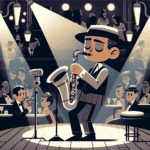Introduction to Sidney Bechet's Soprano Saxophone Style
When we talk about jazz icons, Sidney Bechet is a name that stands tall, especially for his mastery on the soprano saxophone. If you're an aspiring saxophonist wanting to emulate Bechet's style, you're in the right place. We'll explore what made his playing unique and how you can incorporate his techniques into your own performance.
Sidney Bechet's soprano saxophone sound blended soulful expression with technical brilliance. Born in 1897 in New Orleans, Bechet was a child prodigy who began playing the clarinet and eventually switched to soprano saxophone. His impact on jazz is remarkable, and many consider him one of the first important soloists in jazz music.
The Bechet Sound: Key Elements
How did Bechet create such an unforgettable sound? Let's break down the main components:
| Element | Description | How to Practice |
|---|---|---|
| Vibrato | Faster and wider than most, giving his playing a uniquely rich and expressive quality | Start slow with a metronome and gradually increase speed while maintaining pitch control |
| Phrasing | Natural, flowing style akin to a vocalist | Listen to Bechet's recordings and mimic his phrase endings |
| Improvisation | Simple melodies as the foundation for solos | Start with a simple melody and gradually add embellishments |
| Fingerings | Alternative fingerings for specific tonal effects | Experiment with different fingerings for smoother transitions |
Mastering Bechet's Vibrato
Bechet's vibrato was mesmerizing. It involved a slight variation in pitch that added warmth and emotion to his notes. His vibrato was faster and wider than most, giving his playing a uniquely rich and expressive quality. To practice your vibrato, start slow with a metronome and gradually increase the speed while maintaining control over your pitch variations.
Phrasing Like Bechet
Bechet's approach to phrasing was distinctive. He treated his saxophone like a vocalist would treat their voice, with a natural, flowing style. Each note had purpose, contributing to the overall storytelling of the music. To master this, listen closely to Bechet's recordings and try to mimic the way he ends phrases, often with a slight emphasis or swell. With practice, this will become instinctive in your playing.
Bechet's Approach to Improvisation
Bechet's improvisational skills were exceptional. His solos were spontaneous yet melodically coherent. Unlike many jazz musicians who rely heavily on scales, Bechet often used simple melodies as the foundation of his improvisations. This technique makes his solos accessible and memorable. When practicing improvisation, start with a simple melody and gradually add embellishments. Keep it musical and avoid overcomplicating things.
Alternative Fingerings
A lesser-known technique of Bechet's was his use of alternative fingerings. He often employed these to achieve specific tonal effects. This might sound challenging, but mastering alternative fingerings can add a new dimension to your playing. Experiment with different fingerings, and you'll find they can help with smoother transitions between notes, especially during rapid passages.
The Importance of Your Instrument
The instruments you play also matter. Brands like Martin Freres have a reputation for producing high-quality saxophones that can help you achieve a sound closer to Bechet's. The craftsmanship of your instrument can significantly influence your tone and playability, so investing in a well-made saxophone can make a substantial difference.
Emotional Connection to Music
Beyond the technical aspects, capturing Bechet's spirit involves an emotional connection to your music. Bechet played with his heart on his sleeve, and it's important to bring your emotions into your performance. Don't hesitate to experiment and express yourself, as the best music comes from a place of genuine feeling.
Iconic Recordings to Study
To truly understand Bechet's style, study his iconic recordings. Tracks like ‘Petite Fleur,' ‘Summertime,' and ‘Blue Horizon' are excellent starting points. These recordings showcase his technical skills and emotional depth, providing a model for your own playing.
Conclusion
Emulating Sidney Bechet's soprano saxophone style involves a combination of vibrato, phrasing, improvisation, alternative fingerings, and a quality instrument. Remember to bring your emotions into your playing, as that's where the true magic happens. Keep practicing, and soon you'll start to capture the essence of Bechet in your own music.







